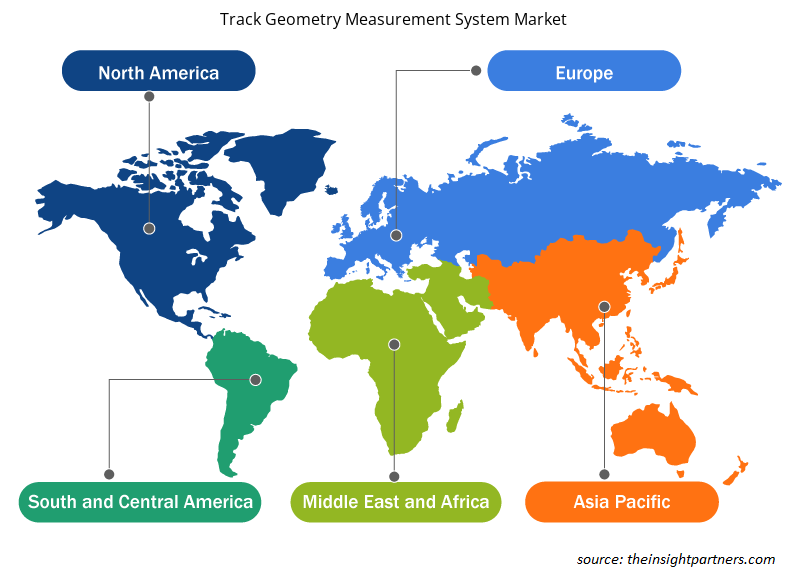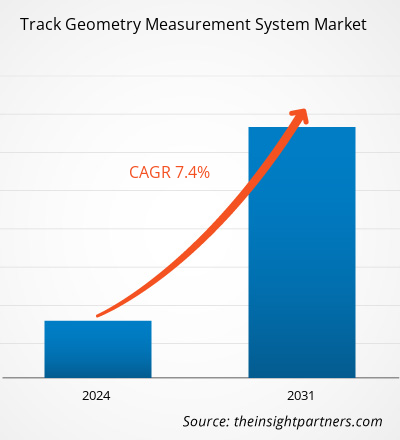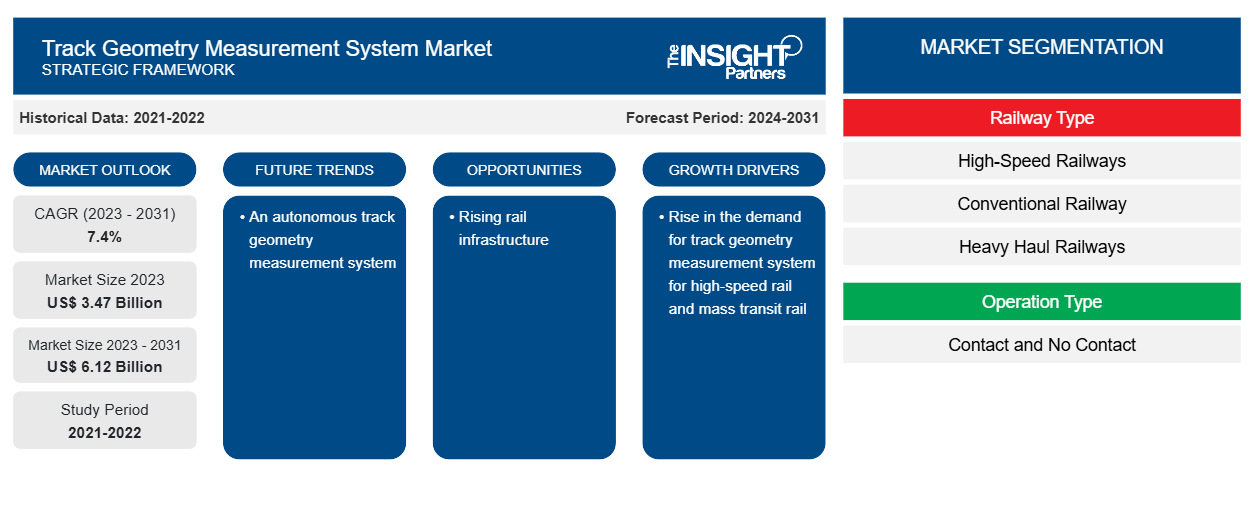Der Markt für Gleisgeometriemesssysteme soll von 3,47 Milliarden US-Dollar im Jahr 2023 auf 6,12 Milliarden US-Dollar im Jahr 2031 anwachsen. Der Markt soll zwischen 2023 und 2031 eine durchschnittliche jährliche Wachstumsrate (CAGR) von 7,4 % verzeichnen. Die steigende Nachfrage nach Lösungen zur Erhöhung der Sicherheit im Schienenverkehr und zur Erweiterung des Schienennetzes dürfte weiterhin der Schlüssel zu den Markttrends für Gleisgeometriemesssysteme sein.
Marktanalyse für Gleisgeometriemesssysteme
Die Eisenbahnindustrie unterliegt zahlreichen Vorschriften und Normen, und um diese einzuhalten, ist ein System zur Messung der Gleisgeometrie erforderlich. Die steigende Nachfrage nach Sicherheit im Schienenverkehr sowie der Ausbau von Eisenbahnnetzen und U-Bahn-Linien sind wichtige Wachstumstreiber der Branche. Zahlreiche Pannen und Unfälle mit Zügen haben weltweit Besorgnis ausgelöst und Regierungen dazu veranlasst, das Transportmittel zu digitalisieren, um eine sicherere Fahrt zu gewährleisten. Darüber hinaus treibt die gestiegene Nachfrage nach intelligenten Technologien zur Aufrechterhaltung der Betriebseffizienz von Gleisen das Wachstum des Marktes für Systeme zur Messung der Gleisgeometrie voran.
Marktübersicht für Gleisgeometriemesssysteme
In der Bahnindustrie ist das Gleisgeometriemesssystem die wichtigste Technik zur Bewertung der Gleissicherheit und zur Planung von Wartungsarbeiten. Durch regelmäßiges Messen und Bewerten der Gleisgeometrie können gleisbezogene Entgleisungen vermieden werden, die verheerende Schäden verursachen können. Gleisgeometriezustände sind eine Hauptursache für Entgleisungen durch Fahrzeug-Gleis-Interaktion, wie z. B. Spurweitenversatz, Radaufsteigen und Entgleisungen durch Überrollen der Schiene. Gleisgeometriezustände können auch zu Schienenbrüchen, gebrochenen Befestigungselementen und thermischen Fehlausrichtungen führen. Das Gleisgeometriemesssystem bietet die entscheidende Möglichkeit, sicherzustellen, dass der Gleisgeometriezustand innerhalb akzeptabler Grenzen für einen sicheren Betrieb liegt.
Passen Sie diesen Bericht Ihren Anforderungen an
Sie erhalten kostenlos individuelle Anpassungen an jedem Bericht, einschließlich Teilen dieses Berichts oder einer Analyse auf Länderebene, eines Excel-Datenpakets sowie tolle Angebote und Rabatte für Start-ups und Universitäten.
-
Holen Sie sich die wichtigsten Markttrends aus diesem Bericht.Dieses KOSTENLOSE Beispiel umfasst eine Datenanalyse von Markttrends bis hin zu Schätzungen und Prognosen.
Markttreiber und Chancen für Gleisgeometriemesssysteme
Steigende Nachfrage nach Gleisgeometrie-Messsystemen für Hochgeschwindigkeitszüge und Nahverkehrszüge begünstigt den Markt
Der globale Markt für Gleisgeometriemesssysteme wird aufgrund der gestiegenen Nachfrage nach Hochgeschwindigkeitszügen voraussichtlich schnell wachsen. Die Entwicklung von Hochgeschwindigkeitszügen hat stetige Fortschritte gemacht und den globalen Markt für Gleisgeometriemesssysteme angekurbelt. Einer der Haupttreiber des Marktes für Gleisgeometriemesssysteme ist das Vorhandensein einer breiten Palette von Spezifikationen und Gesetzen der Bahnindustrie sowie die Notwendigkeit, Gleisgeometriemesslösungen zu integrieren, um diese Standards einzuhalten. Weitere Faktoren, die den Markt für Gleisgeometriemesssysteme antreiben, sind die Einführung von Gleisgeometriesystemen für die Gleiswartung und der Ausbau der U-Bahn- und Hochgeschwindigkeitszugnetze.
Ausbau der Schieneninfrastruktur
Die globale Nachfrage nach Transportmitteln steigt immer schneller. Laut der Internationalen Energieagentur (IEA) werden sich die Passagier- und Frachtaktivitäten im Jahr 2019 bis 2050 voraussichtlich verdoppeln. Laut der Weltbankgruppe sind Eisenbahnen eine der effizientesten Möglichkeiten, Passagiere und Frachten zu transportieren. Aufgrund dieser wachsenden Transportaktivitäten unterstützt die Weltbankgruppe die Entwicklung der Eisenbahnindustrie, um sie effizienter zu machen. Sie unterstützt die Regierungen der Entwicklungsländer bei der Reform der Eisenbahninfrastruktur und der Eingliederung der Eisenbahnen in das Verkehrsnetz eines Landes. Darüber hinaus investieren auch die Regierungen der Entwicklungsländer, um ihre Eisenbahnindustrie anzukurbeln. Laut der India Brand Equity Foundation wird das Land bis 2030 rund 715,41 Milliarden US-Dollar in die Eisenbahninfrastruktur und -entwicklung investieren. Solche Investitionen und Initiativen der Regierung und von Verbänden kurbeln das Wachstum der Eisenbahnindustrie an. Somit erzeugt die wachsende Eisenbahninfrastruktur die Nachfrage nach Lösungen zur genauen Bewertung der Gleisgeometrie unter verschiedenen Betriebsbedingungen.
Segmentierungsanalyse des Marktberichts zum Gleisgeometriemesssystem
Wichtige Segmente, die zur Ableitung der Marktanalyse für Gleisgeometrie-Messsysteme beigetragen haben, sind Eisenbahntyp, Betriebsart und Komponente.
- Nach Eisenbahntyp ist der Markt in Hochgeschwindigkeitsbahnen, konventionelle Eisenbahnen, Schwerlastbahnen und Stadtbahnen unterteilt . Das Segment der konventionellen Eisenbahnen hatte im Jahr 2023 den größten Marktanteil.
- Basierend auf der Betriebsart ist der Markt in Kontakt und kein Kontakt segmentiert. Das Kontaktsegment hatte im Jahr 2023 den größten Marktanteil.
- Nach Komponenten ist der Markt in Hardware, Software und Dienstleistungen segmentiert. Das Hardwaresegment hatte im Jahr 2023 den größten Marktanteil.
Marktanteilsanalyse für Gleisgeometriemesssysteme nach geografischer Lage
Der geografische Umfang des Marktberichts zum Gleisgeometrie-Messsystem ist hauptsächlich in fünf Regionen unterteilt: Nordamerika, Asien-Pazifik, Europa, Naher Osten und Afrika sowie Südamerika/Süd- und Mittelamerika.
Der asiatisch-pazifische Raum wird voraussichtlich das höchste CAGR-Wachstum aufweisen. Die rasante Entwicklung der Schienensysteme in der Region erfordert robuste Lösungen zur Verbesserung der Schienensicherheit, was den Markt für Gleisgeometriemesssysteme im asiatisch-pazifischen Raum antreibt. Der Ausbau der Eisenbahnnetze und U-Bahn-Linien in der Region treibt das Wachstum des Marktes für Gleisgeometriemesssysteme in der Region weiter voran.
Regionale Einblicke in den Markt für Gleisgeometriemesssysteme
Die regionalen Trends und Faktoren, die den Markt für Gleisgeometriemesssysteme während des gesamten Prognosezeitraums beeinflussen, wurden von den Analysten von Insight Partners ausführlich erläutert. In diesem Abschnitt werden auch die Marktsegmente und die Geografie von Gleisgeometriemesssystemen in Nordamerika, Europa, im asiatisch-pazifischen Raum, im Nahen Osten und Afrika sowie in Süd- und Mittelamerika erörtert.

- Erhalten Sie regionale Daten zum Markt für Gleisgeometrie-Messsysteme
Umfang des Marktberichts zum Gleisgeometrie-Messsystem
| Berichtsattribut | Details |
|---|---|
| Marktgröße im Jahr 2023 | 3,47 Milliarden US-Dollar |
| Marktgröße bis 2031 | 6,12 Milliarden US-Dollar |
| Globale CAGR (2023 - 2031) | 7,4 % |
| Historische Daten | 2021-2022 |
| Prognosezeitraum | 2024–2031 |
| Abgedeckte Segmente |
Nach Eisenbahntyp
|
| Abgedeckte Regionen und Länder |
Nordamerika
|
| Marktführer und wichtige Unternehmensprofile |
|
Dichte der Marktteilnehmer für Gleisgeometrie-Messsysteme: Die Auswirkungen auf die Geschäftsdynamik verstehen
Der Markt für Gleisgeometriemesssysteme wächst rasant, angetrieben durch die steigende Endverbrauchernachfrage aufgrund von Faktoren wie sich entwickelnden Verbraucherpräferenzen, technologischen Fortschritten und einem größeren Bewusstsein für die Vorteile des Produkts. Mit steigender Nachfrage erweitern Unternehmen ihr Angebot, entwickeln Innovationen, um die Bedürfnisse der Verbraucher zu erfüllen, und nutzen neue Trends, was das Marktwachstum weiter ankurbelt.
Die Marktteilnehmerdichte bezieht sich auf die Verteilung der Firmen oder Unternehmen, die in einem bestimmten Markt oder einer bestimmten Branche tätig sind. Sie gibt an, wie viele Wettbewerber (Marktteilnehmer) in einem bestimmten Marktraum im Verhältnis zu seiner Größe oder seinem gesamten Marktwert präsent sind.
Die wichtigsten auf dem Markt für Gleisgeometrie-Messsysteme tätigen Unternehmen sind:
- Balfour Beatty plc
- Bentley Systems, Inc.
- ENSCO, Inc.
- ESIM Srl
- Fugro
- Goldschmidt
Haftungsausschluss : Die oben aufgeführten Unternehmen sind nicht in einer bestimmten Reihenfolge aufgeführt.

- Überblick über die wichtigsten Akteure auf dem Markt für Gleisgeometrie-Messsysteme
Marktnachrichten und aktuelle Entwicklungen zum Gleisgeometrie-Messsystem
Der Markt für Gleisgeometriemesssysteme wird durch die Erfassung qualitativer und quantitativer Daten nach Primär- und Sekundärforschung bewertet, die wichtige Unternehmensveröffentlichungen, Verbandsdaten und Datenbanken umfasst. Im Folgenden finden Sie eine Liste der Entwicklungen auf dem Markt:
- Im November 2023 vergab Brightline einen Auftrag an ENSCO Rail zur Bereitstellung autonomer Eisenbahninspektionstechnologie für sein erweitertes Netzwerk in Florida. Die Gleisgeometrie- und Schienenverschleißmesstechnologie von ENSCO verwendet Sensoren und Algorithmen, um Schienenparameter in Echtzeit zu messen und eine umfassende Bewertung des Gleiszustands des Netzwerks zu ermöglichen. Durch die autonome Überwachung des Zustands der Gleisinfrastruktur unterstützt diese Technologie Asset-Management-Entscheidungen, um das Schienennetz von Brightline in Betrieb zu halten. (Quelle: Brightline, Pressemitteilung, 2023)
Marktbericht zum Gleisgeometrie-Messsystem – Umfang und Ergebnisse
Der Bericht „Marktgröße und Prognose für Gleisgeometrie-Messsysteme (2021–2031)“ bietet eine detaillierte Analyse des Marktes, die die folgenden Bereiche abdeckt.
- Marktgröße und Prognose auf globaler, regionaler und Länderebene für alle wichtigen Marktsegmente, die im Rahmen des Projekts abgedeckt sind
- Marktdynamik wie Treiber, Beschränkungen und wichtige Chancen
- Wichtige Zukunftstrends
- Detaillierte PEST/Porters Five Forces- und SWOT-Analyse
- Globale und regionale Marktanalyse mit wichtigen Markttrends, wichtigen Akteuren, Vorschriften und aktuellen Marktentwicklungen
- Branchenlandschaft und Wettbewerbsanalyse, einschließlich Marktkonzentration, Heatmap-Analyse, prominenten Akteuren und aktuellen Entwicklungen
- Detaillierte Firmenprofile
- Historische Analyse (2 Jahre), Basisjahr, Prognose (7 Jahre) mit CAGR
- PEST- und SWOT-Analyse
- Marktgröße Wert/Volumen – Global, Regional, Land
- Branchen- und Wettbewerbslandschaft
- Excel-Datensatz
Aktuelle Berichte
Erfahrungsberichte
Grund zum Kauf
- Fundierte Entscheidungsfindung
- Marktdynamik verstehen
- Wettbewerbsanalyse
- Kundeneinblicke
- Marktprognosen
- Risikominimierung
- Strategische Planung
- Investitionsbegründung
- Identifizierung neuer Märkte
- Verbesserung von Marketingstrategien
- Steigerung der Betriebseffizienz
- Anpassung an regulatorische Trends























 Kostenlose Probe anfordern für - Markt für Gleisgeometrie-Messsysteme
Kostenlose Probe anfordern für - Markt für Gleisgeometrie-Messsysteme